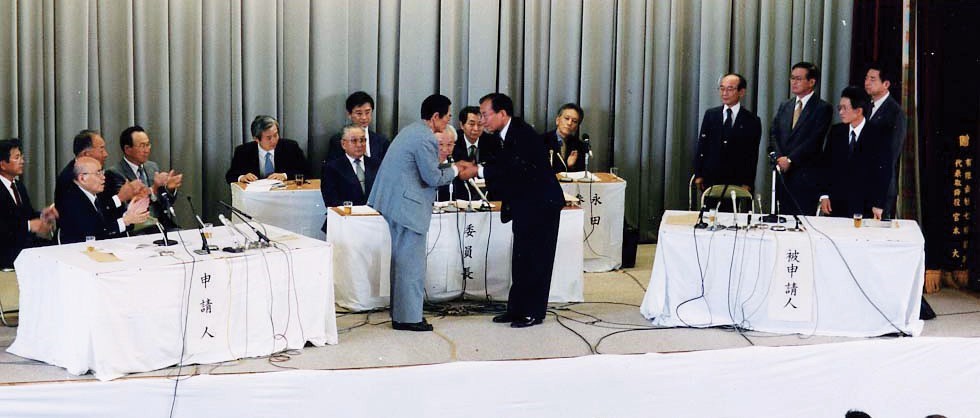Formerly, settling environmental disputes through civil procedures required time and cost, and the relief of the victims was not necessarily sufficient. The Environmental Dispute Settlement System was established to eliminate such a disadvantage on the part of the victims. Therefore, the system has various characteristics, in comparison with civil procedures, such as that environmental dispute settlement organs can conduct investigations by themselves, and the procedures are more flexible and less expensive.
Expert knowledge held by Commissioners and members of environmental dispute settlement organs is fully utilized to facilitate prompt and appropriate settlement. Depending on cases, academics, etc. with specialized knowledge or technological knowledge are appointed as expert advisors.
Environmental dispute settlement organs may collect materials and conduct investigations by themselves as necessary for finding out the cause-effect relationship.
The Environmental Dispute Coordination Commission sets a standard period for adjudication procedures and endeavors to achieve prompt proceedings.
Application fees are relatively low compared with legal costs (fees for applying for conciliation are approximately one-quarter of those for civil conciliation by the court). Additionally, material collection and investigations are conducted at the expense of the administration as necessary, thereby mitigating the financial burden of the parties.
The Environmental Dispute Coordination Commission endeavors to hold hearings at locations of damage to reduce the burden of the parties who live away from Tokyo. When the Adjudication Committee permits, certain documents may be submitted by email.
The Environmental Dispute Coordination Commission and the Prefectural Pollution Review Boards give opinions through their specific experience of settling disputes to the heads of the administrative agencies and Prefectural Governors concerned, respectively. Then the administrative agencies and Prefectural Governors can reflect the experience into their anti-pollution policies for further improvements.
When legal obligations imposed through conciliation, mediation, or adjudication of liability are not adequately performed, environmental dispute settlement organs may make recommendations to demand the performance of said obligations based on a claim made by the right holder. Environmental dispute settlement organs may also request reports on the performance of said obligations from the relevant party or conduct investigations.
Under the Environmental Dispute Settlement System, a large number of dispute cases have been settled. As of March 31, 2022, after the inauguration of the system in 1970, the Environmental Dispute Coordination Commission was involved in a total of 1,101 cases, of which 1,053 were terminated, and the Prefectural Pollution Review Boards held a total of 1,721 cases of which 1,680 were concluded.
Immediately after the inauguration, industrial pollution cases, such as those related to the Minamata Disease, which caused serious damage to people’s health and property, were often brought in.
In addition to the abovementioned types of disputes, there has been an increase in other urban-type or life-related disputes in recent years over neighborhood noise or cases relating to waste treatment facilities for seeking protection of a favorable living environment. Progress in urbanization and people’s heightened awareness of the environment exists in the background.
In November 1993, 438 residents in Teshima, Tonosho-cho, Shodo-gun, Kagawa Prefecture, filed an application with Kagawa Prefectural Governor for conciliation to seek the removal of industrial waste. The residents designated Kagawa Prefecture, the waste disposal company, and waste generating companies, etc., as the other parties (respondents). As the site of the incident covered areas of multiple prefectures, this case was transferred to the Environmental Dispute Coordination Commission the following month.
Through 14 sessions of conciliation proceedings, in July 1997, an interim agreement was reached that Kagawa Prefecture would carry out the intermediate treatment of the waste that remained on the disposal site. At the 37th session of conciliation proceedings in June 2000, conciliation was concluded between the applicants and Kagawa Prefecture.
As it required a long time to complete the implementation of the agreement, the Commission took part in the Teshima Waste Disposal Council to ensure that the Council would perform its function smoothly and appropriately.

In August 2004, the Toyama District Court commissioned the Environmental Dispute Coordination Commission to decide on the cause-effect relationship between the sand washout from the Dashidaira Dam in the marine area at the mouth of Kurobe River and the fishery damage identified at that area.
Through the investigation by experts and 14 sessions of hearings, in March 2007, the Commission rendered an adjudication to partially recognize the alleged causal relationship, finding that the poor harvest of cultivated seaweed was attributed to the sand washout.
In July 2006, 34 residents in Kamisu City, Ibaraki Prefecture, and other municipalities, filed an application with the Environmental Dispute Coordination Commission for an adjudication of the liability to their health from arsenic, designating the State (represented by the Prime Minister) and Ibaraki Prefecture as the other parties (respondents). (Another five residents claiming damages resulting from the same cause participated in the proceedings of the case in November 2008.)
Through the investigation by experts and 17 sessions of hearings, in May 2012, the Commission rendered an adjudication to order Ibaraki Prefecture to pay a total of 28,260,000 yen as a solatium for the applicants.